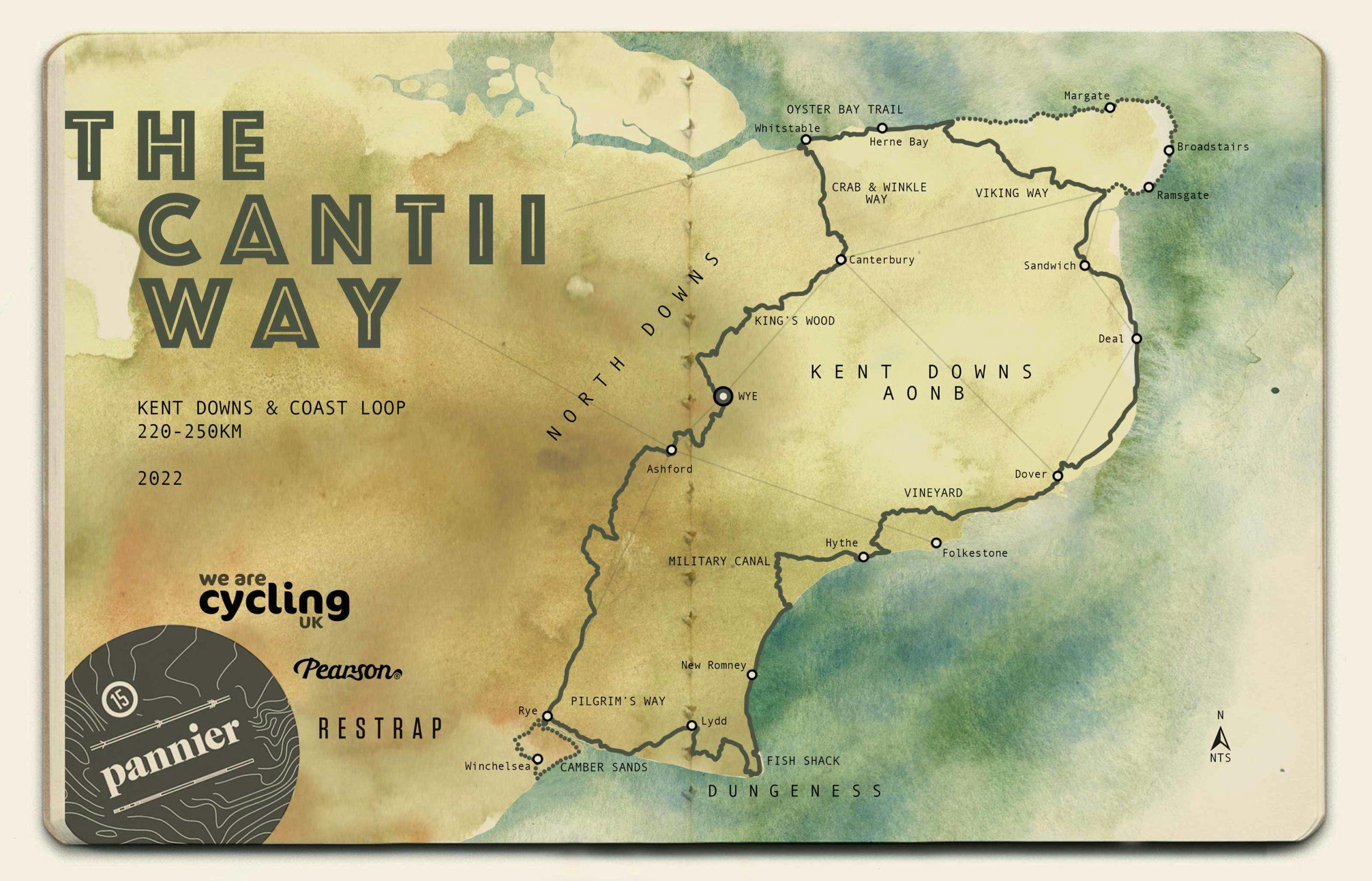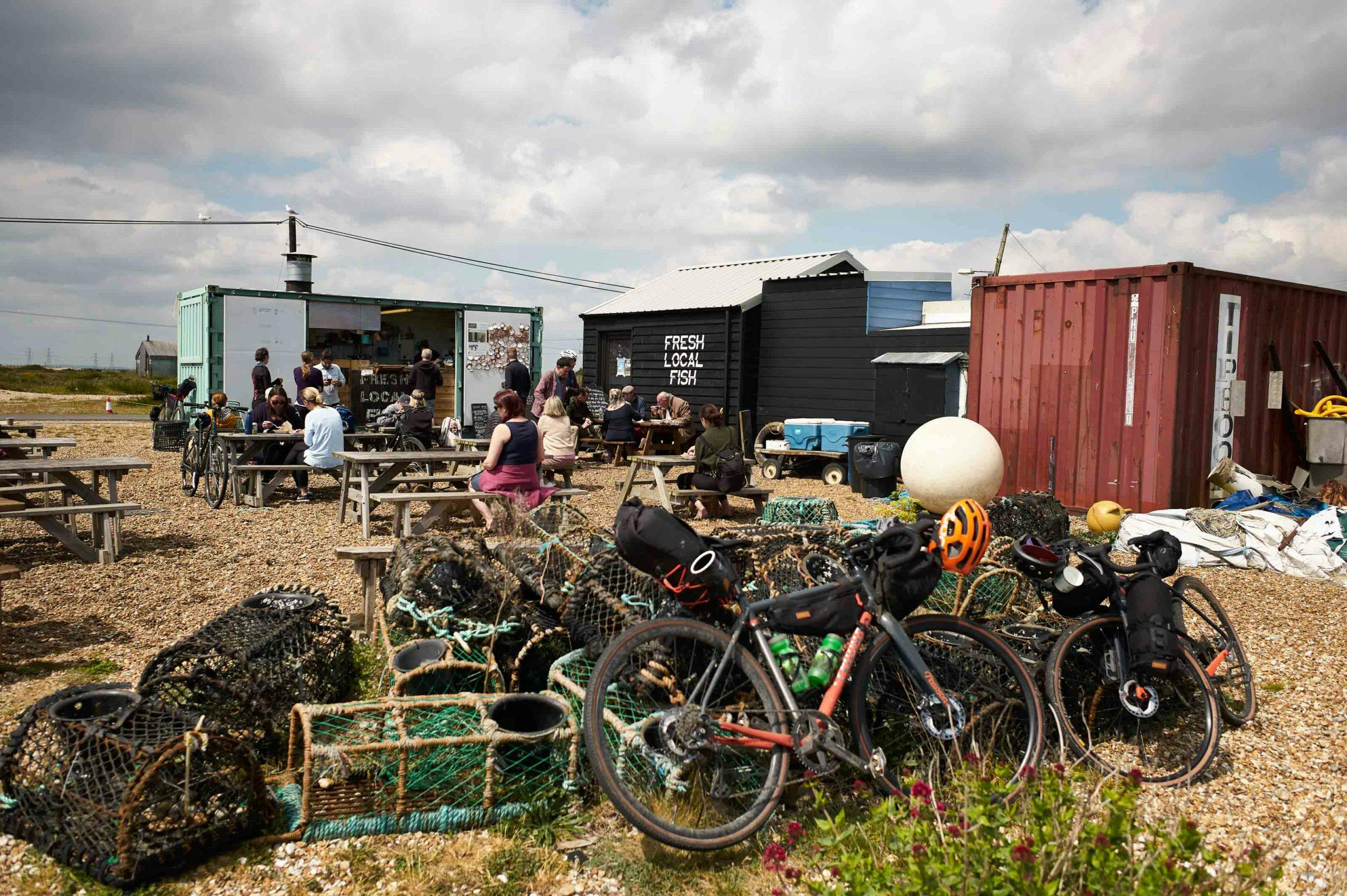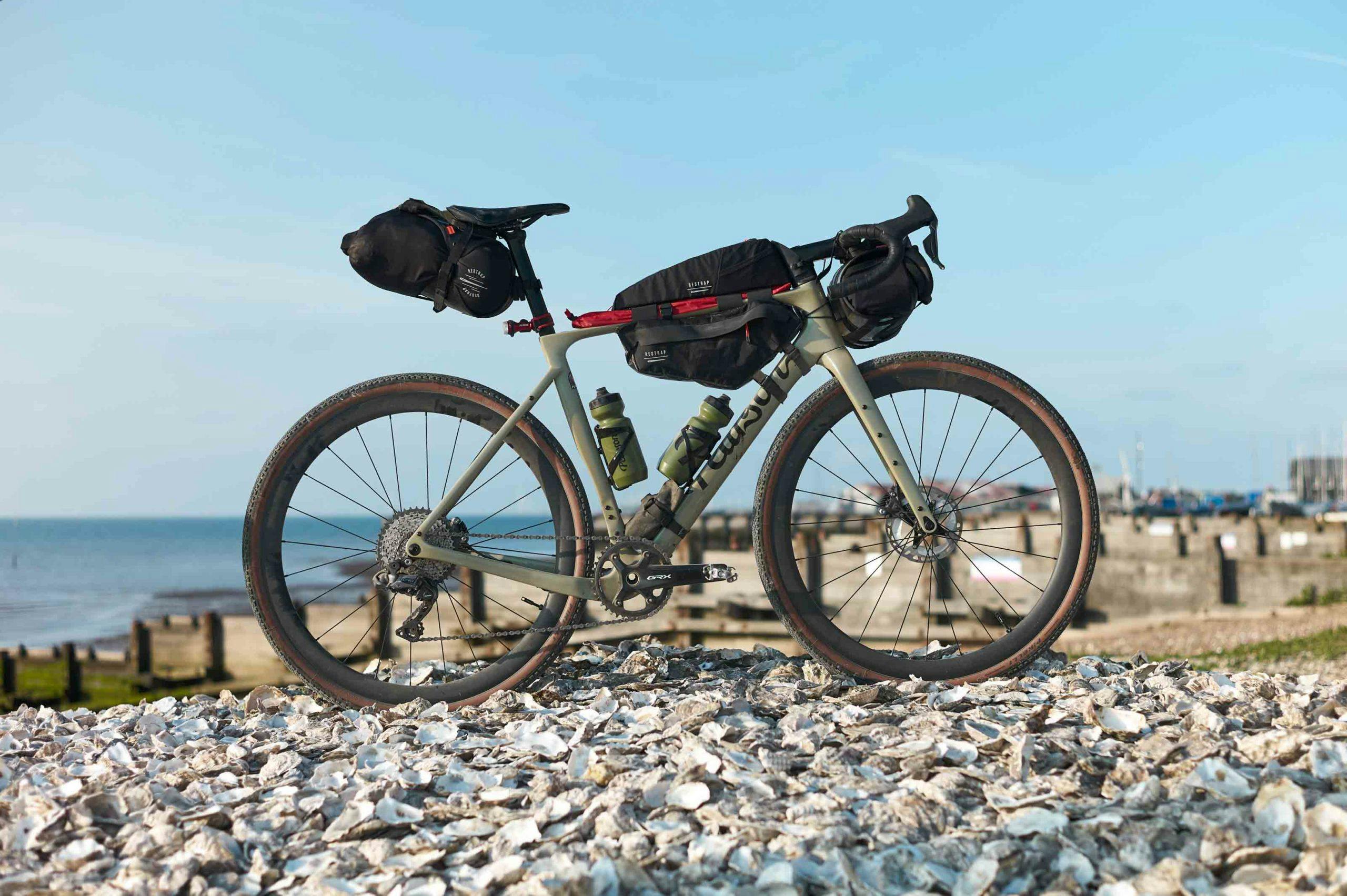
Cantii Way / Pearson Cycles / Restrap
CANTII [n]
An Iron-Age Celtic tribe that occupied the south-eastern corner of Britain (now known as Kent), from around the second century BC.
Just twenty minutes into the trip, and I’d learned enough to go home a happy man. Up at Wye Crown – carved into chalk to celebrate the coronation of King Edward V11 in 1902 – we rode across Ian and his hiking group. “Do you know where the word ‘canter’ comes from?” he proudly muttered. “Well, let me tell you anyway: pilgrims travelling to visit St. Thomas Becket’s grave in Canterbury wanted to make quicker ground than a trot – a bit like you lot – but not so aggressive as to a gallop … so they coined the term a ‘Canterbury Gallop‘ for the in-between. It was used so much, that it was soon shortened to a canter.”
…how apt a verb as ‘canter’ to describe a social group bikepacking pace?; certainly for our three-days in Kent, anyway…





Springtime is a special, vivid time to be riding the Kent Downlands. Rapeseed carpeted the rolling farmland a humming bright yellow, whilst blankets of bluebells scatter the birch and pine forests with a mauve mist as we enjoyed our first and finest gravel section of the trip, through the King’s Wood. At the Wood’s highpoint, cantering pilgrims had their first sighting of Canterbury Cathedral. Like carrot and stick. For us modern bikepacking pilgrims in search of escape, social and enjoyable trails, we’d have to wait a while longer for our carrots; at least until after a friendly dog-walker barked on about a Jane Austen Folly in the Woods. She spent a lot of time in King’s Wood, apparently. Jane Austen, not the dog-walker. Like much of the South Downs, these North Downs tracks and trails are chalky and flinty under tyre, but nothing a beginner to bikepacking can’t ride. In many ways, the perfect introduction to off-road riding.
Onwards to Canterbury and a picnic at the Goods Shed for us, before taking on the Crab and Winkle Way to Whitstable, Herne Bay and the north coastline where we’d spend our first night. The Crab and Winkle Way is a flat section – a beeline of gravel and tarmac laid over the old pioneering tourist railway line to Whitstable and England’s oyster capital, back in the 1800’s. The route along the coast is known as the Oyster Bay Trail for good reason; there was absolutely no option but to pause, rest bikes against seafood crates by the harbour, and enjoy the sunset whilst shucking sundowner oysters – the Whitstable ‘Native’ of which, taking five-years to reach marketable size, are still a protected food and have been for centuries. After a proper fish and chip supper, we continued along the serene north Kent coast concrete path until our campsite near Minnis Bay appeared to our right, through twilight skies.











“…modern bikepacking pilgrims in search of escape, social and enjoyable trails.”

Awaking to rain on the north coast, we were quick to pack tents, brew coffees and sink an oats brekky before traversing across to the south coast, and the best section of the route – hugging the coastline from Sandwich to Rye via the other Cinque Port towns of Dover, Hythe and New Romney. A hotel night in Folkestone to look forward to, break up the camping, and allow for a recoup sure helped in the rain – no need to think about unpacking and erecting wet kit. We also had a vineyard visit planned and a meal in central Folkestone booked; staying in towns often makes things easier. In my opinion, a good mix between towns and wilder camping is desirable, especially when riding in a group. Thankfully the weather improved, and with jackets flapping from shoulders and the bike trailer in the sea-breeze (headwind) to dry off, we cruised along the coast. But, not before a sandwich in Sandwich.
The Cinque Ports (‘Five Harbours‘) dotted along the Kent Peninsula (the shortest distance across the channel) date back to Anglo-Saxon times, but more officially from 1135-ish and were originally established for military and trade purposes. Riding past Deal Pier, the Dover Ferry Port and long haulage hold-ups, it is clear that they are now just leisure and trade focused. The Cinque Ports and Ancient Towns still hold ceremonial status, but the clifftop brutalist concrete Sound Mirrors – the ‘listening ears’ for detecting enemy aircraft – hark back to a time when this coastline was militarised in contemporary times too, though.
Around Dover, we were to pass several fully-loaded cycle tourists embarking on the first kilometres of NCN Route 1 that runs the length of the UK up to John-O-Groats. A reminder that the Cantii Way route we were riding was an accessible adventure for those that can’t afford the time for a trip like that, or are just starting out bikepacking and in search of a shakedown trip. A quick cyclist’s wave and a nod of appreciation and we were off – we had a date at a Kent vineyard to make…











At the end of a private track, in the rolling hills above Folkestone, sits the family-owned and run Terlingham Vineyard. One of around 500 vineyards now in the UK, they practise natural farming and have around 5500 vines. The well-draining chalk slopes provide an ideal ‘terroir’ for vines, hence why you find many vineyards on the South and North Downs of England. The guys at Terlingham also claim their proximity to the sea, and its fresh, salty breeze – the minerality – help produce a fine crop. Surrounded by rapeseed fields, our visit to this small pocket of North Downs in mid-May, was just in time to catch ‘bud bursting’ season, as the flowers and vines started to bloom and come out of winter hibernation. Harvest in September takes them two days, all by hand, when the grapes are left to age for 6-9 months at a local winery (to call a wine a sparkling wine you have to age for 9 months and in bottle for 12 months, minimum). Walking all the 5500 vines makes for a 7KM walk.
For the tyre geeks, sparkling wines are stored at 90psi. Apparently, back in the day, the English beat the French to nailing sparkling wines because they could make stronger glass; French wine ended up all over the floors and walls for decades before they eventually caught up with bottle-making to withstand such pressures.
Terlingham produce a rose, a red, a sparkling white and a sparkling rose. All lovely, especially after a 70KM day with nothing but a speedy descent into Folkestone left to ride, and a couple of bottles strapped to the trailer to enjoy over the next couple of evenings.


“for the tyre geeks, sparkling wines are stored at around 90psi”




“Sea to the left of you,
Bungalows to the right…”
The nuclear-power peninsula of Dungeness had been on my radar for a long while, given my former life as an architect. I had never been, though, until riding the Cantii Way and what a joy/oddity in equal measures! Oli, a friend, ex-colleague and keen cyclist who lives in Folkestone, was right when he said the stretch from Folkestone to Dungeness is very much a “sea to the left of you, bungalows to your right” ride, minus the ace old military canal and farmland singletrack section beyond Hythe.
Riding the road into the Dungeness Estate felt very much a taboo, with the NO PHOTOGRAPHY signs, vast emptiness, and imposing nuclear power station backdrop. And yet, once there, passing iconic housing project after project and an amazing break at the Dungeness Snack Shack for delicious deckchair seafood rolls, scallops and shandies, things slowly started to feel legitimate. Looking out over the shale and small fishing boat silhouetted horizon, it was clear a lot of these houses developed from old fishing shacks in this rather no-mans-land setting. Simon Conder does well to sum up the place – “Dungeness Beach is a classic example of ‘Non Plan’ and the houses that populate the beach have developed through improvisation and bodge … responding to the tradition drama and harshness of the landscape”. Bodge is a good term for it.
We didn’t stick around, keen to keep riding onto Rye to enjoy the Winchelsea and Rye Harbour Nature Reserve Loop in the evening light. The route kisses the choo-chooing tiny tourist train between Dungeness-New Romney and the imposing power station fence, before following the giant pylon highway out and amongst the lovely RSPB Reserve, where people looked through binoculars and large camera lenses for Skylarks and Oyster Catchers.
The village of Camber, and its wide Camber Sands beach, make the ideal snack and swim stop if the weather is good. Just do your best to keep sand off your bike’s drivetrain!











The picture-perfect cobbled Mermaid Street in Rye greeted us after completing the loop out to Winchelsea. We’d heard about the institution that is the Mermaid Inn and, with cellars dating back to the 12th Century and original building still pretty much standing, even at 5’8, I was ducking to get through the door. What a special place though – steeped in history – we couldn’t not stop for an end-of day drink to join the list of many pilgrims, smugglers and traders that have sheltered and supped in The Mermaid over the centuries.
After following the coastline for two days, leaving Rye on the last leg of the Cantii Way would be the last time we saw saltwater, as we headed back inland into the Kent Downlands, and classic Kent riding country – scattered with Oast Houses Hop fields.
The last 40KM of the Cantii Way sure are quick rolling and before we knew it, we were back in Wye enjoying a toast to a lovely escape in a place I wouldn’t normally consider touring by bike. A pleasant surprise for sure, and certainly one for the opportunistic adventure, social trip, or bikepacking beginner…













The group rode a variety of bikes from Pearson Cycles, all kitted out with a mix of Restrap‘s Classic and Race/Adventure range. In Pannier style, we rode the Cantii Way unsupported, which meant carrying all our camping kit and supplies too:
Simon, Laura & Roff – Off-Grid (Carbon gravel bike)
Tom – On and On (Carbon aero gravel bike)
Stef – Around the Outside (Ti expedition bike)
Jordan – Summon the Blood (Ti gravel bike – featuring one of the new Classified rear hubs!)












250KM
2050M+
Quiet Touring Roads, Cobbled Streets, Forest Trails, Bridleways, Coast Paths
Riding the Cantii Way route (including Winchelsea loop, minus the Margate loop) took us two half-days (to account for travel) and two full days – three days in total – and would suggest that is a decent pace to get around and still do a couple of cultural things off-the-bike. Some of you will, of course, be happy doing 250KM over two days … or even in a oner. This bikepacking route is a lot flatter than Cycling UK’s previous King Alfred’s Way and West Kernow Way routes and, bar major headwinds, fairly pacey to ride.
The route is designed to be ridden clockwise, with a start/finish at Cycling UK’s hub of Wye. However, given it is a loop, you can start/finish wherever is most convenient. Ashford or Whitstable would likely be best for those coming via train. Leaving Wye, and the overly nice and helpful guys at New Flying Horse Inn, at lunchtime on Day 1, we overnighted in:
_ Minnis Bay – Camping (60KM)
_ Folkestone – Hotel (65KM)
_ Rye Foreign – Camping (85KM)
before finishing back in Wye on the last day (40KM).
Bear in mind that, whilst a lot of the sections are locally signed as bike routes, the ‘Cantii Way’ route is not signposted, so you will need a GPS device and/or map to navigate.

What can you expect from the Cantii Way bikepacking route?
Everything from a traditional touring escape – the perfect social, leisure, and beginners or family bikepacking trip. Over sunny days in the saddle, riding coastal Kent and the Garden of England sure does offer that unexplainable ‘holiday’ feeling. With the Cantii Way’s terrain and elevation profile, you’ll have ridden 50KM+ before you know it, and whilst nothing is ever ‘wild’ or too far off-the-beaten-track on this 250KM route, it means the route brings plenty of re-supply options, pubs, foodie outlets, beaches, forests, nature reserves, towns and villages to enjoy and explore without too much worry or hassle.
Bikepacking with a beach windbreak? Dymchurch’s vast beaches stood out for spending some time at. There, or Camber Sands…
With the majority of the route sealed and tarmac roads, lanes and tracks – you could ride the Cantii Way on a road bike with decent-sized tyres (/a ‘hybrid’). That said, there are a couple of short chunky sections (King’s Wood springs to mind) which you’d likely be walking if you’re not too confident off-road, anyway (nothing wrong with that!) so it is advisable to stick to the fast-rolling sealed, rather than off-road mountain bike end of the spectrum when it comes to the right bike. Of course, you could ride the whole route on a mountain bike. But, the best bike would definitely be a hybrid or a gravel bike with 35-45c tyres.
You’ll notice I did it with a trailer. It is definitely possible to do this route with a haulage, or a kids trailer and take the family. There were maybe one-two times on the official route when I had to de-couple and lift/steer the trailer through a kissing gate, over fallen trees, or across sandy sections, but otherwise the Cantii Way makes for a great trailer route.
With the route’s proximity to towns, villages, and re-supply, this is definitely a multi-day route you could bikepack on an electric bike (e-bike) if you wanted, too.






Kent is known as the ‘Garden of England’ for good reason. Inland produce is great, but most notable sure were the seafood stop-offs in Whitstable Harbour, Little Rock Restaurant (Folkestone – Harbour Arm) and the Snack Shack (Dungeness).
With the well-drained chalky hills also comes the ideal terrain for hops, orchards and vines, so expect to sample some local Kent wines and beverages on the Cantii Way. Two vineyards on the route we visited were Terlingham (Folkestone) and Charles Palmer (Winchelsea), but I’m sure you can find more if you look hard enough!



Cycling UK naming the route after an ancient tribe hints that there might be a historic element to the route, and Kent in general. On the Cantii Way, you’ll follow various cultural/historic ways – pilgrims on their way from London to Canterbury, traders travelling between Cinque Ports and, more recently, the pioneering train route from Canterbury to Whitstable that took the first revellers to the coast to sample the goods of one of the oldest food companies in Europe – from the Protected Geographic Status Whitstable Oyster beds in the mid-late 1800’s…



Fixed accommodation along the route is as abundant as the beach groynes – you won’t have trouble finding places to stay if you want hotels or B&Bs. Camping, on the other hand, is a bit sparser yet totally doable – both organised and wild. Despite the route’s location and coastal proximity for a lot of it, there are a distinct lack of nice campsites that aren’t holiday parks. Wild camping needs some thought/patience, too.


See you out there! Go well…
Bikepackers
Laura Laker
Simon Usborne
Roff Smith
Tom Hill
Mildred Locke
Will Meyer
Vedangi Kulkarni
Sophie Gordon
Photography
Jordan Gibbons
Stef Amato
Words
Stef Amato
Commercial Partner(s)
Cycling UK
Pearson Cycles
Restrap
Kit/Other Partners
Terlingham Vineyard
WESSEX WANDERINGS: BIKEPACKING KING ALFRED’S WAY
Five Ride Out Of Covid-19 Lockdown, onto King Alfred's Way - a new 350km bikepacking route around the ancient kingdom of Wessex; across vast downlands that somehow echo the comfort of a countryside in which man has always been at home...
by STEF AMATO & DAVE SEAR
LOST WAYS: E-BIKEPACKING THE WEST KERNOW WAY, CORNWALL
Seven head to Cornwall to ride Cycling UK's newest off-road bikepacking route - the West Kernow Way. Expect challenging coastlines, port pasties, hedgerows and hike-a-bikes, post-industrial gravel, seawater swims ... and electric gravel bikes
by STEFAN AMATO & JORDAN GIBBONS
BIKEFISHING THE SECRET DALE
Bikefishing? Oh yes. We strap fishing rods, flies, and overnight kit to our gravel bikes for a bike-fishing journey along the River Nidd. Along the way, we meet up with Nidderdale AONB fly fisherman, Oscar, who takes us upstream fishing in the river and stillwater fishing at the local upland reservoir. Time to see what the bike fishing hype is all about...
by STEF AMATO & DUNCAN PHILPOTT
WESSEX WANDERINGS: BIKEPACKING KING ALFRED’S WAY
Five Ride Out Of Covid-19 Lockdown, onto King Alfred's Way - a new 350km bikepacking route around the ancient kingdom of Wessex; across vast downlands that somehow echo the comfort of a countryside in which man has always been at home...
by STEF AMATO & DAVE SEAR
LOST WAYS: E-BIKEPACKING THE WEST KERNOW WAY, CORNWALL
Seven head to Cornwall to ride Cycling UK's newest off-road bikepacking route - the West Kernow Way. Expect challenging coastlines, port pasties, hedgerows and hike-a-bikes, post-industrial gravel, seawater swims ... and electric gravel bikes
by STEFAN AMATO & JORDAN GIBBONS
BIKEFISHING THE SECRET DALE
Bikefishing? Oh yes. We strap fishing rods, flies, and overnight kit to our gravel bikes for a bike-fishing journey along the River Nidd. Along the way, we meet up with Nidderdale AONB fly fisherman, Oscar, who takes us upstream fishing in the river and stillwater fishing at the local upland reservoir. Time to see what the bike fishing hype is all about...